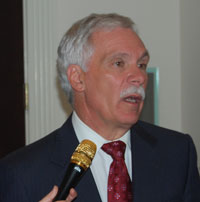 Ames, Iowa-based biodiesel maker Renewable Energy Group Inc. and nutritional ingredient manufacturer Kemin Industries Inc. have finished a study and released the esults of a multi-feedstock biodiesel oxidation.
Ames, Iowa-based biodiesel maker Renewable Energy Group Inc. and nutritional ingredient manufacturer Kemin Industries Inc. have finished a study and released the esults of a multi-feedstock biodiesel oxidation.
Biodiesel Magazine reports that for 10 weeks, the companies performed a detailed analyses of oxidative stability characteristics in pure biodiesel (both B100) made from soybeans and a combination of vegetable oil and animal fats:
The research, which was conducted to gain a better understanding of oxidative stability and degradation of multi-feedstock biodiesel in long-term storage, found that in tests simulating extreme storage conditions, oxidative stability decreased rapidly in untreated B100 as measured by oil stability index induction time, Peroxide Value (PV), 1,4-decadienal and Hexanal content.
“Antioxidant treatment delayed these changes,” said Glen Meier, REG manager of research and development, said antioxidant treatment delayed the changes. “Results show that dosage rates will depend on the specific biodiesel product and its feedstock composition, as well as the storage and handling protocols in place.”
In addition, the group determined that late “rescue” treatments did not eliminate secondary oxidation products, even when oil stability index (OSI) induction time could be increased. As well, it was found that oxidation in products measured indicated changes to B100 that may foster polymer and sediment formation in blends and support earlier use of antioxidants to preserve quality.
The research is expected to help petroleum and biodiesel storers prevent oxidative stability problems in less-than-ideal storage conditions.
 Jim Sullivan of Informa Economics in Washington, D.C. told a crop outlook seminar at the American Farm Bureau Federation 90th annual meeting that the global recession will mean weakening demand for corn and soybeans this year, except when it comes to ethanol and biodiesel.
Jim Sullivan of Informa Economics in Washington, D.C. told a crop outlook seminar at the American Farm Bureau Federation 90th annual meeting that the global recession will mean weakening demand for corn and soybeans this year, except when it comes to ethanol and biodiesel.

 This week’s major economic speech from President-elect Barack Obama pointed out how ethanol and biodiesel, as well as other alternatives to conventional energy sources, will be key to the nation’s economic recovery.
This week’s major economic speech from President-elect Barack Obama pointed out how ethanol and biodiesel, as well as other alternatives to conventional energy sources, will be key to the nation’s economic recovery. In an effort to quell skepticism over the renewable energy industry’s chances to meet the 10.5-billion Renewable Fuels Standard in 2009, the National Biodiesel Board has reaffirmed its industry’s ability to hold up its end of the deal… and then some.
In an effort to quell skepticism over the renewable energy industry’s chances to meet the 10.5-billion Renewable Fuels Standard in 2009, the National Biodiesel Board has reaffirmed its industry’s ability to hold up its end of the deal… and then some. “The U.S. biodiesel industry’s contribution to the nation’s fuel supply will help ensure that the RFS targets for 2009 will be met,” said Manning Feraci, NBB’s Vice President of Federal Affairs. “In 2008 alone, the U.S. biodiesel industry produced nearly 700 million gallons of biodiesel, which equates to 1.05 billion ethanol equivalent gallons for purposes of the RFS.”
“The U.S. biodiesel industry’s contribution to the nation’s fuel supply will help ensure that the RFS targets for 2009 will be met,” said Manning Feraci, NBB’s Vice President of Federal Affairs. “In 2008 alone, the U.S. biodiesel industry produced nearly 700 million gallons of biodiesel, which equates to 1.05 billion ethanol equivalent gallons for purposes of the RFS.” Speaking to reporters this week, Secretary Ed Schafer noted that growth in ethanol and biodiesel production have helped create “remarkable prosperity and growth in the agriculture economy” during the Bush administration.
Speaking to reporters this week, Secretary Ed Schafer noted that growth in ethanol and biodiesel production have helped create “remarkable prosperity and growth in the agriculture economy” during the Bush administration.  Less than two weeks after Air New Zealand took to the air in a flight powered by jatropha-based biodiesel, American carrier Continental Airlines has used a combination of the the weed and algae to fuel one of its 737s.
Less than two weeks after Air New Zealand took to the air in a flight powered by jatropha-based biodiesel, American carrier Continental Airlines has used a combination of the the weed and algae to fuel one of its 737s. U.S. Sen. Christopher “Kit” Bond, a longtime friend of renewable and clean energy efforts, has announced he will not seek re-election in 2010.
U.S. Sen. Christopher “Kit” Bond, a longtime friend of renewable and clean energy efforts, has announced he will not seek re-election in 2010. The National Biodiesel Board is welcoming a new face to its great communications team.
The National Biodiesel Board is welcoming a new face to its great communications team. Robinson has been involved in the communications industry for more than a decade, most recently serving as Press Secretary for Missouri Governor Matt Blunt when the state adopted a ten percent ethanol standard, and for the first time began fully funding biodiesel incentives. Robinson has worked in radio and television news stations in New Mexico, Missouri and Florida. She is a graduate of the University of Missouri’s School of Journalism.
Robinson has been involved in the communications industry for more than a decade, most recently serving as Press Secretary for Missouri Governor Matt Blunt when the state adopted a ten percent ethanol standard, and for the first time began fully funding biodiesel incentives. Robinson has worked in radio and television news stations in New Mexico, Missouri and Florida. She is a graduate of the University of Missouri’s School of Journalism. In addition to Federal tax credits, Michigan fueling station owners can now receive 30 percent up to $20,000 to install E85 or biodiesel. Rep. Joel Sheltrown introduced House bill 5878’08 in March 2008, and it was signed into law on December 30 of last year.
In addition to Federal tax credits, Michigan fueling station owners can now receive 30 percent up to $20,000 to install E85 or biodiesel. Rep. Joel Sheltrown introduced House bill 5878’08 in March 2008, and it was signed into law on December 30 of last year. Colorado-based
Colorado-based  Ames, Iowa-based biodiesel maker Renewable Energy Group Inc. and nutritional ingredient manufacturer Kemin Industries Inc. have finished a study and released the esults of a multi-feedstock biodiesel oxidation.
Ames, Iowa-based biodiesel maker Renewable Energy Group Inc. and nutritional ingredient manufacturer Kemin Industries Inc. have finished a study and released the esults of a multi-feedstock biodiesel oxidation.